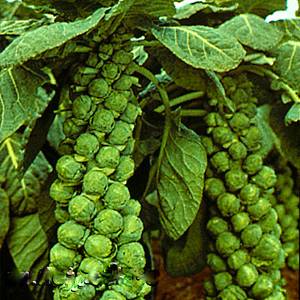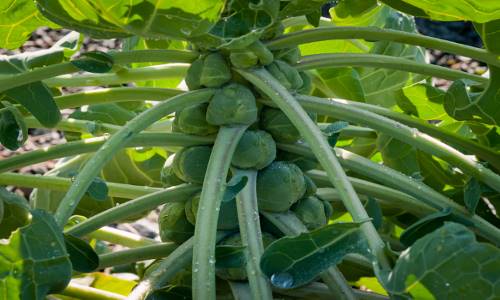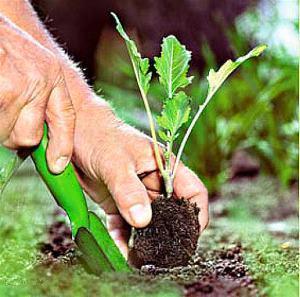Brussels sprouts - cultivation and care
 Brussels sprouts are native to Belgium, from where this plant spread to Holland, Germany and France, as well as to other countries of Western Europe.
Brussels sprouts are native to Belgium, from where this plant spread to Holland, Germany and France, as well as to other countries of Western Europe.
This cabbage is rich in nutrients and tastes good. Dense small heads of Brussels sprouts are used in the preparation of first and second courses, and they can also be pickled for the winter.
Brussels sprouts varieties
All varieties of Brussels sprouts are subdivided into early maturing, mid-maturing and late-maturing.
Mid-season Brussels sprouts:
- Rosella - has a good yield (up to 50 heads of cabbage are harvested from one stem);
- Cassio - is characterized by a high yield (up to 60 heads of cabbage).
Late-ripening varieties:
- Hercules 1342 - disease resistant, is the most common, frost resistant;
- Dallik - characterized by high resistance to keel;
- Curl is a variety of domestic selection, frost-resistant.
Early maturing varieties:
- Franklin F1 - ripening period 130 days;
- Dolmik F1 is the best variety taking into account the peculiarities of growing Brussels sprouts in Siberia and the Urals.
The stalk of cabbage reaches 40-60 cm, depending on the variety. Heads of Brussels sprouts are green-yellow, can reach a mass of up to 20 grams, and up to 0.5 kg are harvested from one specimen (the yield depends on the variety).

Features of growing Brussels sprouts
In order to get a good harvest of cabbage heads, the cultivation of Brussels sprouts should be carried out taking into account the exactingness of the crop to the soil and the place of growth. Seedlings of cabbage planted in fertile loams with neutral or low acidity pH. Well bred for the cultivation of Brussels sprouts lit place, because due to a lack of light, the heads of cabbage on the stem will not have time to form and gain mass.
This type of cabbage should be planted after root vegetables, legumes, early tomatoes and pumpkin crops. In order to prevent many diseases, and especially keels, Brussels sprouts are not recommended to be planted after crucifers.
Features of growing Brussels sprouts in Siberia and the Urals
The growing season for Brussels sprouts lasts 160-180 days, so in the middle latitudes this crop is grown only by seedling.
For seed germination, 3 degrees of heat is enough, and when it rises to 20 degrees, shoots appear on the 4th day.
The seedling boxes are filled with soil mixture composed of peat and sod land with the addition wood ash and complex mineral fertilizer... Garden land for growing seedlings of Brussels sprouts is not used in order to minimize the risk of pest and keel infestation. Seeds are laid out in holes to a depth of 2 cm. You can sow cabbage for seedlings from the second decade of April. If places in the greenhouse no, seeds for seedlings can be sown under a film in a place well warmed by the sun.
Water the seedlings of Brussels sprouts as the soil dries up in the box. It is important not to overflow, otherwise the seedlings will disappear. When 4-7 true leaves are formed on the plant, the seedlings are ready for transplanting into open ground.
Planting seedlings of Brussels sprouts is carried out taking into account weather conditions (from May 15), and for the regions of Siberia and the Urals, the dates are shifted to early June.
Ideal for growing Brussels sprouts will be the ridge on which they grew last year cucumbers, tomato or legumes. When transplanting cabbage seedlings, you do not need to add fertilizer to the hole, since the ridge has been prepared in the fall. If there was no autumn refueling, 2 weeks before planting, a bucket of humus, half a liter of chalk or ash, 100 g is introduced into the soil. nitrophosphate. The soil with fertilizers is dug up, leveled and spilled with an additional solution of potassium permanganate (1.5 grams of substance is taken in a bucket of water). This is a good prevention of keela and other cruciferous diseases.
 Seedlings of Brussels sprouts are carefully removed from the box, keeping a clod of earth.
Seedlings of Brussels sprouts are carefully removed from the box, keeping a clod of earth.
Planting is carried out in rows, maintaining a distance of 60 cm between the plants. The soil around the stem is compacted so that the wind does not tilt the plant. Best of all, cabbage seedlings grown cassette or pot method, because during transshipment, a clod of earth retains its shape.
Since Brussels sprouts develop for a long time (almost six months), the beds with this crop can be used more rationally by planting cucumbers, early tomatoes, lettuce and other vegetables and herbs in the aisles.
Care
 After planting the seedlings, you need to provide proper care for the Brussels sprouts. It is practically the same as for cauliflower, only you do not need to huddle.
After planting the seedlings, you need to provide proper care for the Brussels sprouts. It is practically the same as for cauliflower, only you do not need to huddle.
Watering... Over the entire growing period, Brussels sprouts are watered 10 times, spending 400 liters of water per 10 square meters of planting until the heads of cabbage form on the stem, and 450 liters during their growth.
Top dressing... During the season, seedlings are fed twice with mineral fertilizers. Organics are not used as food for this type of cabbage.
- The first time Brussels sprouts are fed a week after planting in open ground. A teaspoon of nitroammophoska is consumed for 2 holes.
- The second feeding is carried out for already grown plants, when the rudiments of heads of cabbage begin to appear on the stems. As a top dressing, a solution is used: in 10 liters of water, 25 grams of nitroammofoska, potassium sulfate and superphosphate... Before top dressing, the soil is shed with water, and then top dressing is applied. For the second feeding, you can use the following fertilizer composition: 30 grams of potassium chloride, 40 grams of superphosphate, 2 grams urea.
Pinching... In September, when 3-4 weeks are left before harvesting, the top of the Brussels sprouts is pinched, the rosette leaves are cut off. It is a decapitation method that promotes the growth of heads of cabbage.
Harvesting... The fact that the heads of Brussels sprouts are ready for picking will be indicated by the color of the first leaves of the heads. They turn yellowish, after which they crumble. A characteristic waxy luster appears on the fruits themselves.